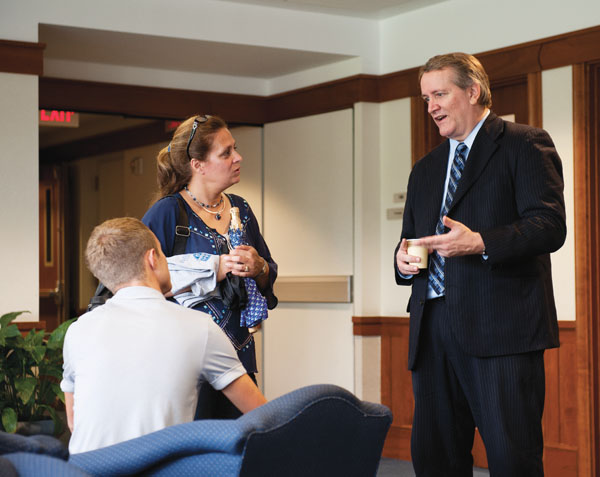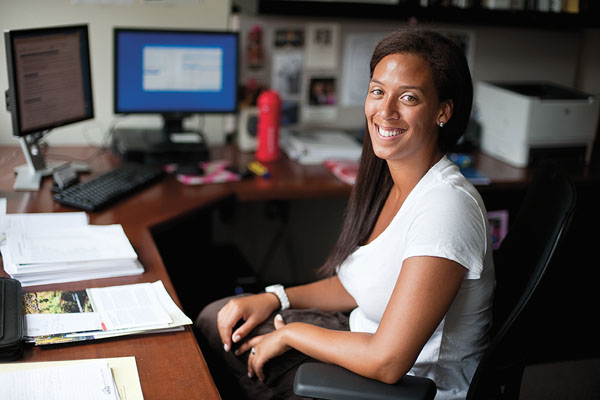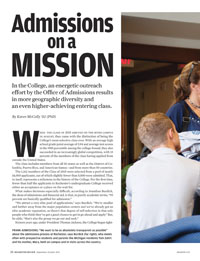Features
 FRANK ADMISSIONS: “We want to be as absolutely transparent as possible” about the admissions process at Rochester, says Burdick (far right), who meets often with prospective students and parents like Michigan residents Tom Zahrt and his mother, Mary, both on campus and in visits across the country. (Photo: Brandon Vick)
FRANK ADMISSIONS: “We want to be as absolutely transparent as possible” about the admissions process at Rochester, says Burdick (far right), who meets often with prospective students and parents like Michigan residents Tom Zahrt and his mother, Mary, both on campus and in visits across the country. (Photo: Brandon Vick)When the Class of 2015 arrived on the River Campus in August, they came with the distinction of being the College’s most selective class ever. With an average high school grade point average of 3.94 and average test scores in the 95th percentile among the college-bound, they also succeeded in an increasingly global competition, with 15 percent of the members of the class having applied from outside the United States.
The class includes members from all 50 states as well as the District of Columbia, Puerto Rico, and American Samoa—and from more than 50 countries.
The 1,162 members of the Class of 2015 were selected from a pool of nearly 14,000 applicants, out of which slightly fewer than 5,000 were admitted. That, in itself, represents a milestone in the history of the College. For the first time, fewer than half the applicants to Rochester’s undergraduate College received either an acceptance or a place on the wait list.
What makes decisions especially difficult, according to Jonathan Burdick, the dean of admissions and financial aid, is that, in purely academic terms, “95 percent are basically qualified for admission.”
“We attract a very elite pool of applications,” says Burdick. “We’re smaller and farther away from the major population centers and we’ve already got an elite academic reputation, so there’s that degree of self-selection in that only people who think they’ve got a good chance to get in go ahead and apply.” But, he adds, “that’s also the group we go out and seek.”
 PERSONAL TOUCH: Counselors such as Selzer know many prospective students by the time their applications arrive. (Photo: Adam Fenster)
PERSONAL TOUCH: Counselors such as Selzer know many prospective students by the time their applications arrive. (Photo: Adam Fenster)It’s the middle of July and the lobby on the first floor of Wallis Hall is buzzing with prospective Yellowjackets. Summer is not a quiet time in Rochester’s Office of Admissions and Financial Aid.
Haniya Selzer ’11W (MS), a native of Syracuse and a graduate of McGill University in Montreal, is a senior admissions counselor who has been at Rochester for five years. Starting in September, she’ll travel for weeks at a time, visiting high schools in her assigned regions. Those regions may change for each counselor from year to year, and often they’re far from contiguous. This year, Selzer will draw applications from her native Syracuse, all of Canada, the city of Beijing, and Minnesota.
“In the summer, we’ll start planning which high schools we want to go to,” she says.
Selzer aims for four school visits a day and will often spend a week in a given area. When schools get back in session, she schedules visits—the sooner the better.
“You try to beat another school in picking the date and time,” she says, alluding to the competition among institutions to attract top students.
By the time Selzer opens a completed application on her computer—these days, applications are submitted online—she’ll often know the applicant, especially if she comes from far away.
“The students from farther away, you get to know better. From Syracuse, we’re getting hundreds of applications.” When she opens an application from afar, she says, “as soon as I see the name, and my interview write-up, I say, ‘oh, of course.’ I know exactly who they are.”
When counselors receive applications, they give what’s called “the first read.” It may take them anywhere from 10 minutes to a half an hour. At the end of a first read, a counselor will rate the applicant on four numeric scales—for academic rigor, extracurricular activities, letters of recommendation, and what Rochester counselors call “the X factor,” as revealed primarily in the student’s essay and interview.
Not all counselors approach the first read in the same way. Selzer looks first at the academic transcript. Dean of Admissions Jonathan Burdick, who also does first reads (his regions this year include Hawaii, New Jersey, the U.S. territories of Guam and the American Somoa, as well as some international regions) says he goes right to the interview and the essay—what he calls “the color”—and looks at objective factors such as grades and test scores last.
It’s subjective, to be sure, which is why each application also gets what’s called a “blind second read.” Second reads are conducted by senior counselors—counselors such as Selzer, who have been in the office for at least four to five years, right up to Burdick. Second readers are randomly assigned applications. They review the applications, with access to the first reader’s notes, but will make a recommendation for or against admission without knowledge of the first reader’s numeric ratings.
In “a huge chunk of cases,” says Burdick (he estimates it ranges from a third to a half) the first and second readers disagree. Every week from January through March, a committee of second readers meets once a week to go through each case.
A large factor, says Burdick, is “the fit.” How much has the student taken advantage of opportunities to get to know the University? And how much do they appear to know about it?
Supplemental materials that applicants send on their own initiative—what Burdick calls “wacky objects”—play scarcely any role. The exception is the student aspiring to study art or music, who sends a recording or portfolio.
The College also strives for diversity in all its aspects: racial, cultural, religious, and more than ever, geographic. Diversity of academic interests and talents is also important.
Burdick is candid about the role finances play in admissions. He estimates that 85 to 90 percent of admitted students “sailed through” without a review of their financial need. For the last 10 to 15 percent, “we were consulting the information about need. Even then, we didn’t reverse even 5 percent of the decisions.”
“I wouldn’t tell any mother who calls me up and says ‘why was my son denied,’ that I’m 100 percent confident that every decision we made was absolutely the right decision,” Burdick says. “I can only tell her that we’ve got a process that we believe in that’s produced good results.”
—Karen McCally
Sixteen years ago, under President Thomas Jackson, the College began tightening standards for admission as part of the Renaissance Plan, a five-year initiative to strengthen and focus the University’s core offerings in arts, sciences, and engineering. For the next several years, that effort meant making fewer offers of admission.
More recently, the College has pursued high standards of admission by building the quality of its applicant pool. For while college and university admissions are more competitive than ever for students, it’s also true that admissions are more competitive than ever for the colleges and universities. Academically rigorous private institutions such as Rochester compete aggressively with one another to attract the interest of the most promising high school—and sometimes middle school—students.
Burdick came to Rochester in 2003 from the University of Southern California, a vast institution with almost 18,000 undergraduates. Its ratio of admitted students to applicants has traditionally been lower than Rochester’s, but Burdick says these ratios can be misleading. At a school such as USC, he says, “you can count on it that the first quarter or even third that they didn’t admit were dismissed out of hand because they didn’t have the academic qualifications.”
A highly qualified applicant pool makes it easy, in practice, to make good on Rochester’s pledge that there are no numerical cutoffs such as minimum GPAs or test scores. But that makes it difficult to whittle down an increasingly large “stack” (applications are now submitted online) of applications.
Burdick says there will be no shortcuts. “We’re responsible for putting out some messages that aren’t very happily received. So I think it’s our responsibility to be extremely careful about why someone is or isn’t getting in,” he says.
Assistant dean of admissions Mark Wells estimates that this past year admissions counselors collectively spent “well over 10,000 hours over a 16-week period dedicated to just trying to narrow down this pool of 14,000 to a manageable number of students who we can actually invite to join our community.”
Rochester’s Office of Admissions and Financial Aid employs more than 70 staff members, not including undergraduates who work for the office as campus tour guides. Almost half, including many supervisory-level staff members, play a direct role in admissions or financial aid counseling. The remainder perform tasks from managing outreach programs, to producing marketing materials, to scheduling and coordinating staff travel arrangements, to facilitating the process from admission to enrollment.
Costas Solomou, who has worked in Rochester’s admissions office for 10 years, is an admissions counselor and the director of admissions programs. This means that he is not only an admissions representative responsible for soliciting and reading applications from his assigned regions, but also oversees Rochester’s developing outreach efforts.
“We’ve been aggressively expanding our markets outside of the Northeast,” he says, using business terms now commonly used in higher education recruitment circles as well.
Expanding outside the Northeast not only promotes the University’s goal of diversity, but also recognizes a demographic reality: the region’s population is declining.
“We’ve been proactive, I think more so than some of our peers,” says Solomou, in responding to the region’s population decline.
One factor that helps Rochester achieve recognition in a national marketplace, of course, is a high ranking from widely read sources such as U.S. News & World Report or Rochester’s designation as a “New Ivy” by Newsweek in 2006. “It’s still resonating,” says Solomou. “Parents still mention it.”
Rochester is buying lists of prospective students’ names and marketing early and often. An expansive Admissions and Financial Aid website includes videos, a blog chock full of information and stories offered by admissions staff and current students, a Twitter feed, and a Facebook presence.
But the largest factor in Rochester’s success may well be what Solomou calls “boots on the ground.”
Rochester now employs regional representatives—admissions outreach personnel who work from far-flung places such as Los Angeles, Chicago, Philadelphia, and Dallas—to put Rochester on students’ radar screens as they begin thinking about college.
“When we first penetrated the California market in places like Los Angeles and San Francisco,” says Solomou, “it was ‘Rochester who? Where’s Rochester? Is that in Minnesota or New York?’” This year, the College welcomed 45 new students from California—43 freshmen and 2 transfer students.
Rochester has also made headway in Texas. In August, Admissions held a barbecue, sponsored by local venues Sticky Lips Pit BBQ and Dinosaur Bar-B-Que, to welcome 24 new students from the state. Such events, Solomou says, “help with the transition from a faraway place to Rochester.”
Solomou mentions two other groups that Admissions has actively drawn into its outreach efforts: parents and alumni. A parent-to-parent program puts parents of current students in touch with parents of prospective students. Events such as cocktail parties and get-togethers for parents “are opportunities where we step away from the process and let it happen organically,” he says.
“We have an army of alumni,” he adds, “attending college fairs, conducting interviews across the country for us—more than 1,300 this year.”
Rochester is also reaching out to talented students at younger ages, following a game-changing trend in the business of higher education. Wells, who has been at Rochester for 14 years, says “Ten to 15 years ago, it was really unheard of to reach out to students much before their junior year in high school.” Now, the practice is common, driven by the increased competition among colleges and universities to attract top talent.
It’s also driven by the efforts of middle and high schools to help young students begin to think ambitiously about their futures. “Whenever we get an inquiry from a middle school, asking ‘Can we bring 40 students to campus for a tour to expose them to college,’ we say ‘Absolutely,’” says Wells. “We’ll find people to staff those events, whenever they take place.”
Rochester has established formal partnerships with a host of community organizations, such as the Boys and Girls Club of Rochester and Upward Bound. In 2007, President Joel Seligman initiated the Rochester Promise, a $25,000-a-year scholarship to qualified students graduating from the Rochester City School District.
Admissions has also helped Rochester to expand its array of on-campus precollege programs. A Taste of College, in which rising high school juniors and seniors take credit-bearing courses with Rochester undergraduates, has been around for about 25 years, says Emily Cihon Fehnel, director of campus programs. In the last five years, however, Admissions has expanded the market for the program by offering participants the experience of living in campus residence halls and adding a full slate of evening activities.
Fehnel, who works closely with the regional directors, as well as other counselors, says the residential component has helped the program to attract students from around the country.
“It’s gaining momentum,” says Fehnel. “And that’s my goal. I want to grow these programs, the residential component especially.” Since fall 2010, almost half of the rising juniors and seniors who have gone through the residential program and were eligible to apply, have applied to Rochester.
In some respects, Rochester might have a steep hill to climb. “We have to work a little bit harder than some of our peers,” says Solomou, referring to Rochester’s location away from populous cities such as Boston and New York.
But Burdick stresses that Rochester isn’t presenting itself as simply another school racking up impressive statistics and high institutional rankings. Part of the outreach effort, he says, is “communicating who we are and what’s important here.”
“We don’t want to communicate how we’re exactly like Y University, but how we’re different. And why you might choose us over Y University—or Y University over us,” he says.
He adds that it’s a challenging task. “We’re beneficiaries of the general attention that great universities are getting. But how you manage that surging interest, how you use that to continue to create a distinctive profile for yourself is still a piece of hard work.”

